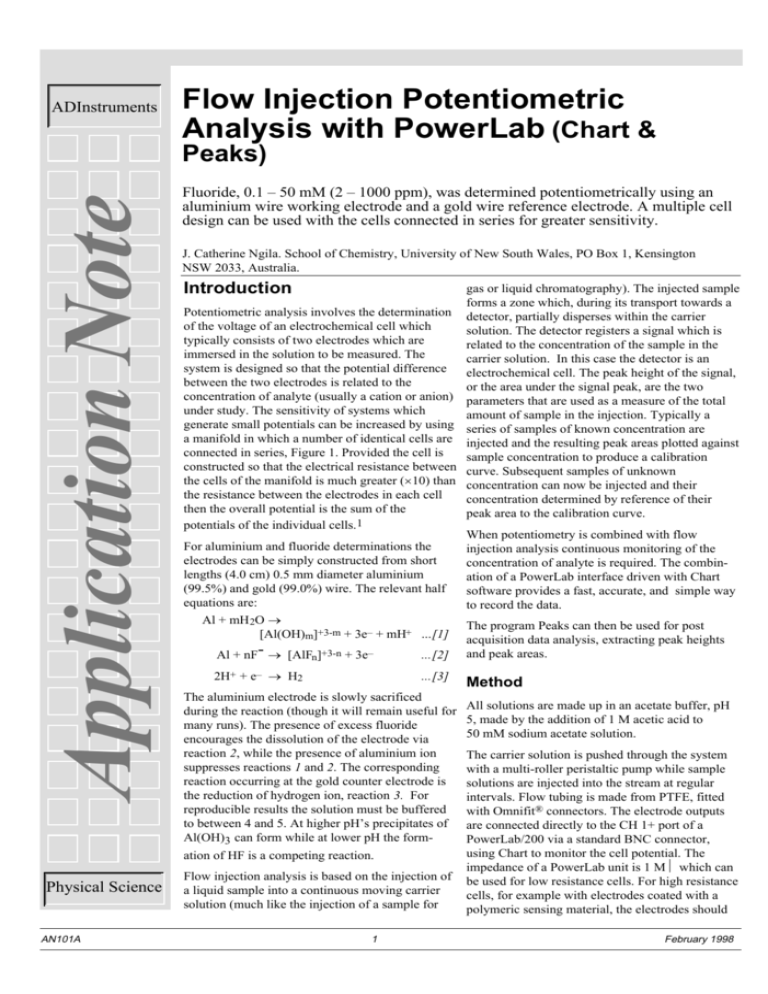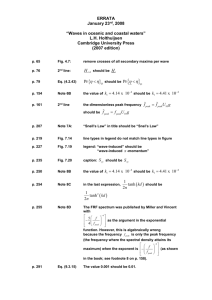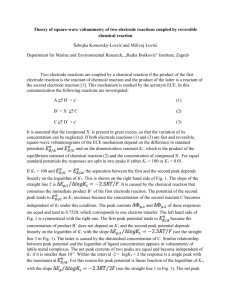
ADInstruments
Flow Injection Potentiometric
Analysis with PowerLab (Chart &
Application Note
Peaks)
Physical Science
AN101A
Fluoride, 0.1 – 50 mM (2 – 1000 ppm), was determined potentiometrically using an
aluminium wire working electrode and a gold wire reference electrode. A multiple cell
design can be used with the cells connected in series for greater sensitivity.
J. Catherine Ngila. School of Chemistry, University of New South Wales, PO Box 1, Kensington
NSW 2033, Australia.
Introduction
Potentiometric analysis involves the determination
of the voltage of an electrochemical cell which
typically consists of two electrodes which are
immersed in the solution to be measured. The
system is designed so that the potential difference
between the two electrodes is related to the
concentration of analyte (usually a cation or anion)
under study. The sensitivity of systems which
generate small potentials can be increased by using
a manifold in which a number of identical cells are
connected in series, Figure 1. Provided the cell is
constructed so that the electrical resistance between
the cells of the manifold is much greater (×10) than
the resistance between the electrodes in each cell
then the overall potential is the sum of the
potentials of the individual cells.1
For aluminium and fluoride determinations the
electrodes can be simply constructed from short
lengths (4.0 cm) 0.5 mm diameter aluminium
(99.5%) and gold (99.0%) wire. The relevant half
equations are:
Al + mH 2O →
[Al(OH)m]+3-m + 3e– + mH+ ...[1]
Al + nF- → [AlFn]+3-n + 3e–
...[2]
2H+ + e– → H2
...[3]
The aluminium electrode is slowly sacrificed
during the reaction (though it will remain useful for
many runs). The presence of excess fluoride
encourages the dissolution of the electrode via
reaction 2, while the presence of aluminium ion
suppresses reactions 1 and 2. The corresponding
reaction occurring at the gold counter electrode is
the reduction of hydrogen ion, reaction 3. For
reproducible results the solution must be buffered
to between 4 and 5. At higher pH’s precipitates of
Al(OH)3 can form while at lower pH the formation of HF is a competing reaction.
Flow injection analysis is based on the injection of
a liquid sample into a continuous moving carrier
solution (much like the injection of a sample for
1
gas or liquid chromatography). The injected sample
forms a zone which, during its transport towards a
detector, partially disperses within the carrier
solution. The detector registers a signal which is
related to the concentration of the sample in the
carrier solution. In this case the detector is an
electrochemical cell. The peak height of the signal,
or the area under the signal peak, are the two
parameters that are used as a measure of the total
amount of sample in the injection. Typically a
series of samples of known concentration are
injected and the resulting peak areas plotted against
sample concentration to produce a calibration
curve. Subsequent samples of unknown
concentration can now be injected and their
concentration determined by reference of their
peak area to the calibration curve.
When potentiometry is combined with flow
injection analysis continuous monitoring of the
concentration of analyte is required. The combination of a PowerLab interface driven with Chart
software provides a fast, accurate, and simple way
to record the data.
The program Peaks can then be used for post
acquisition data analysis, extracting peak heights
and peak areas.
Method
All solutions are made up in an acetate buffer, pH
5, made by the addition of 1 M acetic acid to
50 mM sodium acetate solution.
The carrier solution is pushed through the system
with a multi-roller peristaltic pump while sample
solutions are injected into the stream at regular
intervals. Flow tubing is made from PTFE, fitted
with Omnifit® connectors. The electrode outputs
are connected directly to the CH 1+ port of a
PowerLab/200 via a standard BNC connector,
using Chart to monitor the cell potential. The
impedance of a PowerLab unit is 1 MΩ which can
be used for low resistance cells. For high resistance
cells, for example with electrodes coated with a
polymeric sensing material, the electrodes should
February 1998
About the author
Ms Catherine Ngila is
undertaking her Ph.D.
in Analytical
Chemistry at the
School of Chemistry,
University of New
South Wales. She
already holds a B. Ed.
(Sc.) and
M. Sc. (Environ.
Chem.) from Kenyatta
University. Her
current research
interests include
developing multisensor detection
systems for ionic
substrates for use in
potentiometric flow
injection analysis
systems.
be connected to a pH meter or high impedance
voltmeter with recorder output, which is in turn
connected to the PowerLab unit (ADInstruments
ML165 pH Amp is suitable).
export to a third party spreadsheet or graphing
program, Figures 3 and 4.
Annotation
When Chart is opened channel 1 is resized to fill
the screen. Recording is commenced by simply
clicking the Start button on the screen.
During the recording session you can type
annotations with the Comments feature – for
example the concentrations of the standard
solutions. The Notebook facility can also be used
After recording has begun the carrier solution is
run until a steady baseline signal is obtained (about to writeup overall experimental procedures. In this
way all observations and comments are recorded
2-5 minutes). The standard samples are injected.
About one minute is required for the sample to pass along with the data rather using a separate
notebook.
through the system then a further two minutes is
allowed to elapse while carrier solution is flushed
through to eliminate the possibility of
Data Analysis
contamination between consecutive samples. Thus
The two parameters of importance are the peak
the total time for a single measurement is 3
height and peak area. The peak height is related to
minutes. During this time the signal rises from its
the concentration of the analyte in the sample while
baseline value, reaches its maximum, then returns
to its original level. After all of the standards have the peak area is a function of the total amount of
analyte administered in the injection. Both
been injected a series of samples of unknown
concentration can be measured in a similar manner. quantities can be used for analytical purposes.
Data Display
You can view the data, expand the horizontal or
vertical scale, use the Zoom Window to magnify a
particular region. Make a hard copy of the data by
printing the results with the Print command in the
File menu. Finally the data can be saved as a
compact Chart file, or as an ASCII text file for
As an alternative to injection, the inlet tubing can
be dipped into a standard solution, then placed
back in the blank and this process repeated for all
the standards and then the samples. In this
procedure the peak heights will give a measure of
concentration but since the “dipping” takes place
over slightly different periods of time the peak area
can no longer be related to total amount of analyte.
Perspex electrochemical
cell manifold
Output
PowerLab
ADInstrume
+
CH1
CH2
+
CH3
+
To Waste
CH4
+
+
Trigger
Au
Al
Au
Al
Carrier Solution
from peristaltic
pump
Au
Al
Injection Port
Figure 1. Diagram showing connection of a cell manifold suitable for measuring aluminium and fluoride
ion concentrations. There may be any number of Au/Al cells connected in series but one to six pairs
usually gives good results. For more resistive cells the electrodes should be connected to a MLA165 pH
Amp (or other pH meter with recorder output) which is in turn connected to the PowerLab.
AN101A
2
February 1998
Use can be made of the in built Data Pad feature of
Chart to determine peak heights, however, it is
much easier to save the data as a Chart file then use
Peaks to reopen this file. Set the baseline, threshold
and noise level as required then click on each peak
to give an instant readout of its height and area.
This data can also be extracted from the Report
Window by cutting and pasting into a spreadsheet
or graphing program in readiness for the
preparation of the calibration curve, Figures 3
and 4.
with a commercial membrane ion selective
electrode and a pH meter.
More to do
3. D. B. Hibbert, P.W. Alexander, and P. Yatiman, Mikrochimica Acta, 108: 93 (1992).
References
1. D.B. Hibbert, ‘Introduction to Electrochemistry’, Macmillan, London, 209–210
(1993).
2. D.B. Hibbert, P.W. Alexander, .S. Rachmawati, and S.A. Caruana, Analytical Chemistry,
62: 1015–19 (1990).
The method can also used for the indirect
4. P.W. Alexander, P.R. Haddad, and M. Trojandetermination of aluminium ion in the range 0.5 –
owicz, Analytica Chimica Acta, 171: 93
50 ppm, using a constant fluoride concentration of
(1985).
1.0 mM.
Nitrate can be similarly determined in the range 2 –
1000 ppm using a single flow–through cell fitted
Figure 2. A trace collected by Chart from apparatus similar to that shown in Figure 1.
Only a single pair of electrodes was used.
AN101A
3
February 1998
Trademarks
MacLab and PowerLab are
registered trademarks, and
Chart and Scope are
trademarks, of ADInstruments
Pty Ltd. Other trademarks are
the properties of their
respective owners.
Addresses
International
ADInstruments Pty Ltd
Unit 6, 4 Gladstone Road
Castle Hill, NSW 2154
AUSTRALIA
Phone:+61 (2) 9899 5455
Fax:+61 (2) 9899 5847
Email:enquiries@adi.com.au
Web:
http://www.adinstruments.com
North America
ADInstruments
1949 Landings Dr
Mountain View CA 94043
U.S.A.
Phone:+1 (650) 965 9292
Fax: +1 (650) 965 9293
Email:
info@adinstruments.com
Europe
ADInstruments Ltd
Grove House
Grove Road, Hastings
East Sussex, TN35 4JS
UNITED KINGDOM
Phone: +44 (1424) 424 342
Fax: +44 (1424) 460 303
Email:enquiries
@adi-europe.com
Japan
ADInstruments Japan Inc.
Okajima Bldg 2-10-1
Iwamoto-cho
Chiyoda-ku, 101 Tokyo
JAPAN
Phone:+81 (3) 5820 7556
Fax:+81 (3) 3861 7022
Email:adijapan@po.iijnet.or.jp
Figure 3. The results shown in Figure 2 have been imported into Peaks for display and analysis. The
baseline has been flattened, 5 point moving average smoothing applied, the peaks have been
automatically located and their relative areas and heights determined. The peak areas normalised to
the largest peak have also been determined and can be seen in the Report Window.
4.0
Your local distributor:
3.5
pF
3.0
2.5
2.0
1.5
0.0
0.2
0.4
0.6
0.8
peak height (V)
Figure 4. Data in the Report Window can be cut and pasted into spread sheets or exported to other
graphing programs in order to construct a calibration graph. This calibration graph was prepared with
Igor Pro™. If pF ( = -log10[F-] ) is plotted against signal then a straight line relationship becomes
Copyright. All rights reserved.
AN101A
apparent, E = 1.280 - 0.342 pF, where E is the peak height potential in volts.
4
February 1998










